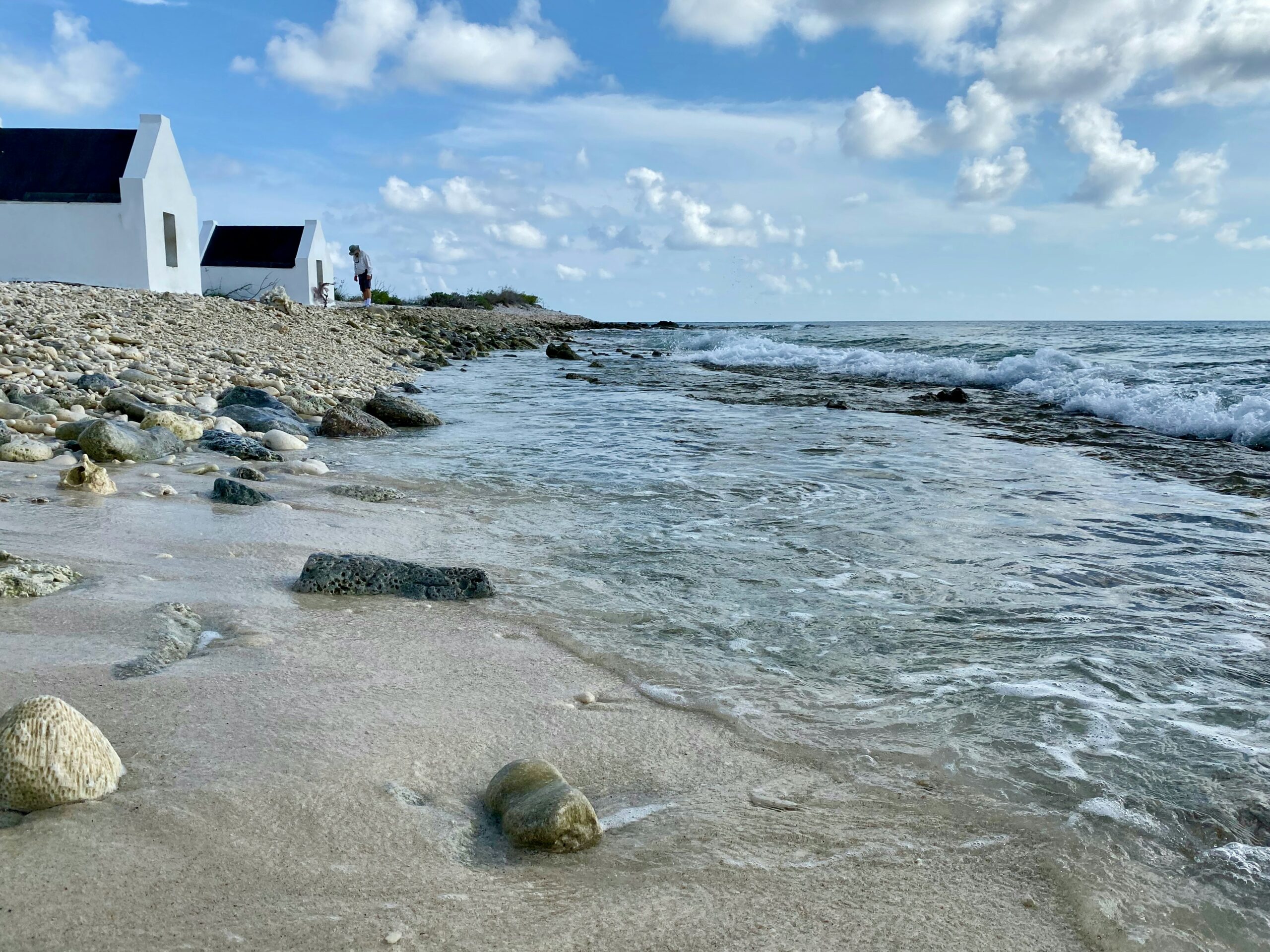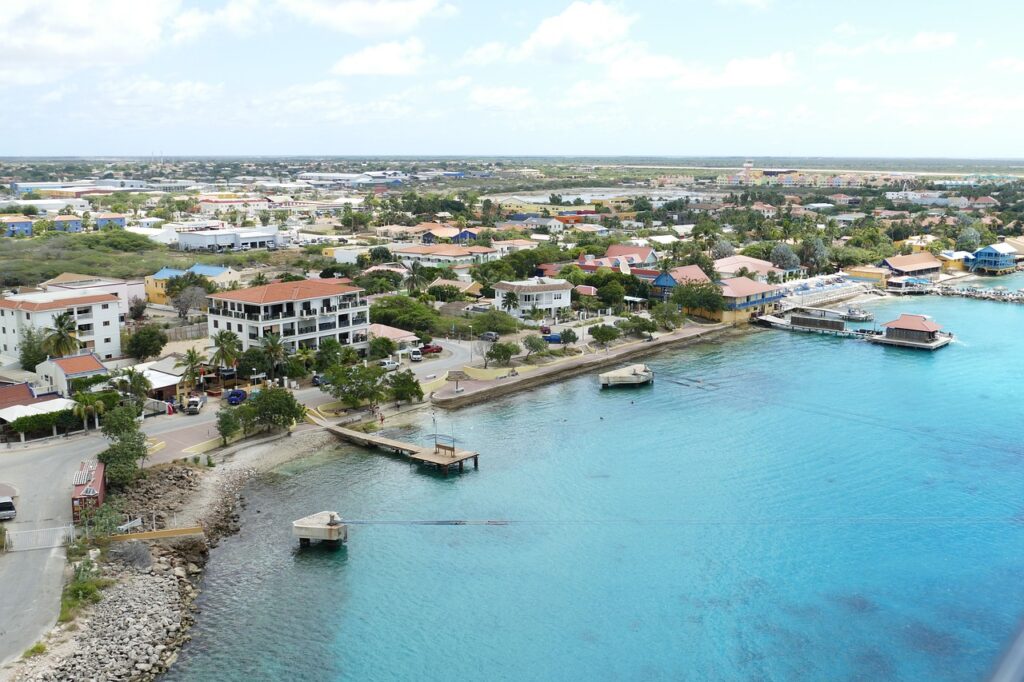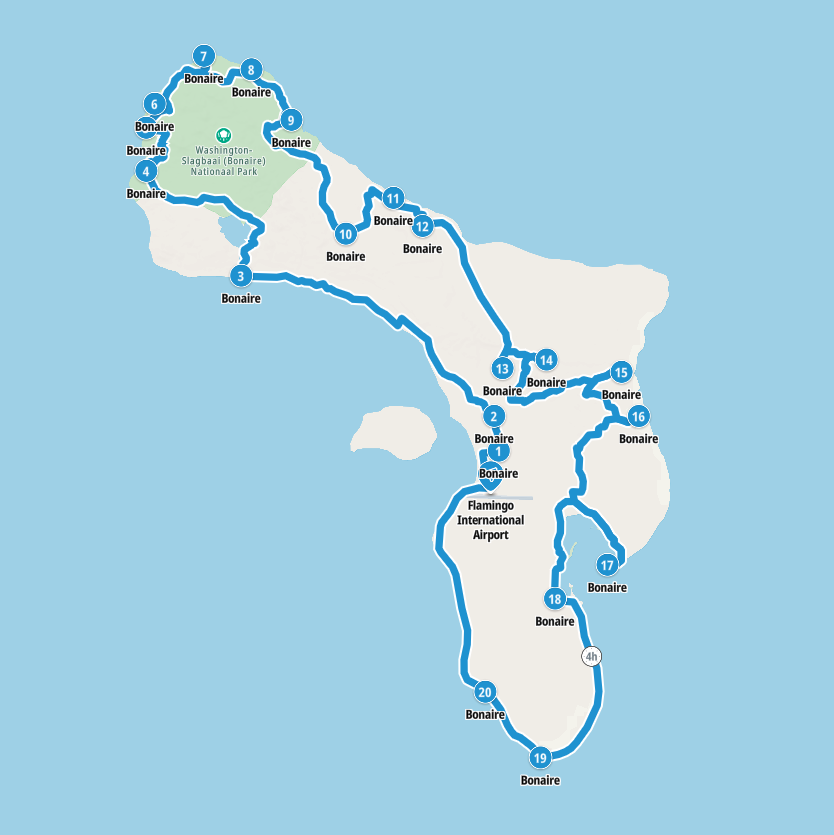Bonaire / Boneiru – Let’s explore here
What’s it like in Bonaire?
Bonaire is an island located in the Caribbean Sea in South America. It is part of the Netherlands, although it’s not part of the EU. Bonaire has a population of around 25,000 people (2024), about two in five of whom live in the capital city, Kralendijk.
The island lies about 50 miles (80 km) from the coast of Venezuela, and is mostly flat with some rolling hills. The highest peak is Mount Brandaris, at 791 ft (241 m) above sea level. There is a small uninhabited island off the coast of Bonaire called Klein Bonaire, which is popular with tourists because of its pristine white beaches.
Although Bonaire relies heavily on tourism like many other Caribbean islands, it is also a tax haven.

A bit about the history of Bonaire
Early History and Indigenous People
Bonaire was originally inhabited by the Caiquetio, an Arawakan-speaking group. These indigenous people lived on the island for centuries before the arrival of Europeans. They were skilled in agriculture, fishing, and pottery. Little is known about the early settlements, as the island was sparsely populated compared to other Caribbean territories.
European Discovery and Dutch Control
Bonaire was first encountered by Spanish explorers in the early 16th century, though the island was largely ignored by the Spanish, who focused on other parts of the Caribbean. In 1633, the Dutch West India Company took control of Bonaire, and the island became part of the Dutch Caribbean colony. During the colonial period, the Dutch established salt production as the main economic activity, utilising the island’s natural salt pans.
Slavery and Economic Development
Like many Caribbean islands, Bonaire’s economy was built on the labour of enslaved Africans. Slavery was introduced to the island in the 17th century to work in the salt mines, which were vital to the Dutch economy. The Dutch also established plantations, primarily for crops like sugarcane and indigo. Slavery persisted in Bonaire until its abolition in 1863, following Dutch colonial reforms.
Post-Slavery Era and 20th Century Developments
After the abolition of slavery, Bonaire’s economy struggled, and the island’s population remained small. In the early 20th century, the island’s salt industry continued to play a significant role in its economy. In the 1950s, Bonaire saw increased tourism, particularly related to its natural beauty and marine life, leading to the development of the island as a popular diving destination.
Modern Bonaire and Political Status
In 1986, Bonaire, along with other islands in the Netherlands Antilles, became a special municipality of the Netherlands. The Netherlands Antilles was dissolved in 2010, and Bonaire was directly integrated into the Kingdom of the Netherlands as a public entity, alongside its neighbours, Sint Eustatius and Saba. The island enjoys a degree of self governance, but foreign affairs and defence are handled by the Dutch government.
Today, Bonaire is known for its commitment to environmental conservation and sustainable tourism. Its marine parks, beaches, and rich cultural heritage attract visitors, especially those interested in scuba diving and nature exploration. The economy is now largely based on tourism, salt production, and the growing services sector.

Bonaire road trip
Bonaire is our third planned stop on our road trip through the islands of the Caribbean. Having explored Curaçao, our next stop is Trinidad and Togbago.
Travelling overland between the islands is quite prohibitive due to the lack of transportation options. Travelling between different island countries via ferry is possible, however, ferries only operate between some islands. Chartering private boats between islands is also possible, although travelling with a car in this way is prohibitive. Flying is another option, although again, flights only operate between some islands.
Map of our road trip through Bonaire

This is a map of our planned road trip around the island of Bonaire, starting and ending in the Flamingo International airport.
Weather in Bonaire
When is the best time to visit Bonaire?
The best time to visit Bonaire is from January to May. During these months, the islands have 8 – 9 hours of sunshine per day and rainfall of 0.5 – 1.8 inches (13 – 45mm) per month. The temperature ranges from 25 – 32°C (77 – 89°F).
When is the worst time to visit Bonaire?
The worst time to visit Bonaire is from July to December. During these months, the islands still have 8 – 9 hours of sunshine per day. However, humidity rises and it rains an average of 1.4 – 3.7 inches (35 – 95mm) per month. The temperature ranges from 26 – 33°C (79 – 91°F).
Hurricane Season in the Caribbean
Hurricane season in the Caribbean runs from June 1 to November 30. Storms tend to be more frequent and more severe in the latter half of the season.
Hurricanes are least likely during December, January and February.
Travel in and around Bonaire
Ferries to and from Bonaire
The Bonaire Ferry travels between Bonaire and Curaçao daily.
There are a number of water taxis that travel between Bonaire and Klein Bonaire daily, including Epic Water Taxis and Caribe Watersport.
What’s it like to drive in Bonaire?
They drive on the right hand side of the road in Bonaire. In the main, roads are in fairly good condition, with some smaller roads being dirt tracks.
Do you require an international driving permit in Bonaire?
We’ve created a dedicated page to driving abroad, which answers this question, and more, which you might find helpful.
Can you use your UK driving license when driving through Bonaire?
We’ve created a dedicated page to driving abroad, which answers this question, and more, which you might find helpful.
Do I need a carnet de passages to drive in Bonaire?
We’ve created a dedicated page to driving abroad, which answers this question, and more, which you might find helpful.
What are the speed limits in Bonaire?
The speed limits for cars in Bonaire are:
- 25 mph (40 km/h) for urban driving
- 35 mph (60 km/h) outside of built up areas
- 35 mph (60 km/h) on dual carriageways
- 35 mph (60 km/h) on motorways
What currency do they use in Bonaire?
In Bonaire they use the US dollar. Cash is widely used. The use of credit / debit cards is widely accepted in tourist areas. Travellers cheques are not generally accepted. There are many ATMs in tourist areas, although not all accept foreign issued cards.
You should make yourself aware of the amount that your bank charges you for using credit and debit cards abroad. Often credit cards are cheaper for purchasing items directly, and for withdrawing cash from ATMs.
What language do they speak in Bonaire?
They speak Dutch and Spanish Creole in Bonaire. Spanish is also spoken widely. English is spoken in tourist areas.
What time zone is Bonaire in?
Remember, when you’re planning your next trip to take a look at what time zone it’s in.
Do I need a visa to visit Bonaire?
We’ve created a dedicated, more comprehensive page on visas, which you should find helpful. Check it out!
Is wild camping legal in Bonaire?
No, wild camping is illegal in Bonaire.
What plug / socket type do they use in Bonaire?
In Bonaire they use plug / socket types A, B and F.



Health issues in Bonaire
Is it safe to drink water in Bonaire?
Yes, it is safe to drink tap water in Bonaire. Bottled water is also readily available across the country.
What vaccinations are required for Bonaire?
This NHS website is kept up to date with all relevant information on vaccinations in Bonaire.
Phones in Bonaire
What is the country calling code for Bonaire?
The country calling code for Aruba is +5997
What are the emergency phone numbers in Bonaire?
- The emergency number for police in Bonaire is: 911
- In Bonaire, the emergency number for ambulance is: 911
- The emergency number for fire in Bonaire is: 911
If you’ve got some useful info that you’d like to share, let us know!
And don’t forget to check out all the other pictures!
